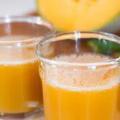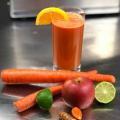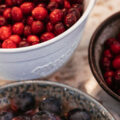Plus Three Recipes: Papaya-Lime, Mango-Pineapple, and Pineapple Passionfruit
Learn our four tricks for juicing “soft” fruits at home (yes, you CAN juice them!) and three new recipes for juicing pineapples, mangoes, papaya, and more.
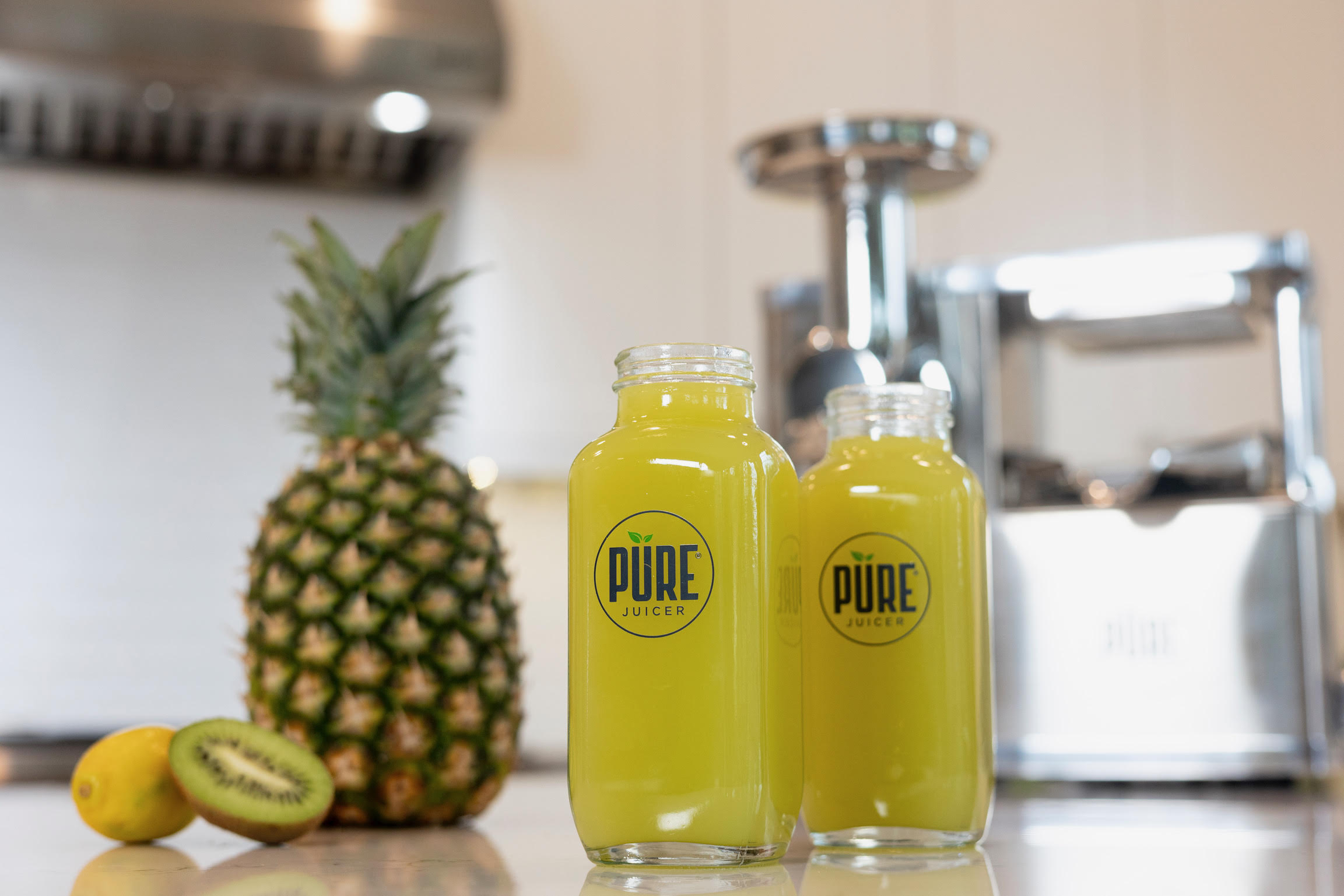
Great News: You can Juice Soft Fruit At Home
Common juicer wisdom tells us that soft fruits like mangoes, papayas, kiwis, and pineapple will squish, splatter in home juicers, and that you’ll end up wasting a great deal of good fresh produce. Recipes on the internet recommend you save these fruits for smoothies and frozen treats.
You’ll also hear that certain “mushy” fruits like mangoes and blueberries won’t provide enough fresh juice, and you’re better off pureeing them.
We’re always in favor of a good puree, but we’re here to tell you it is not only possible to juice fruits with a softer side–but something we insist you really must try! All you need is a food-grade stainless steel juicer with a hydraulic press.

Powerful as a Baby Elephant’s Buns
The PURE Juicer, originally designed to take tough vegetables like carrots, greens, and beets, and fruits like apples into fresh juice, is a powerful kitchen appliance. Using a forceful grinder and powerful hydraulic press, the PURE Juicer produces the highest juice yield with the best nutrient density.
How powerful is the PURE Juicer? Imagine a baby elephant sitting on your fresh produce. Our hydraulic press has that kind of impact!
So how, you may ask, are we able to juice soft fruits with a machine like that? Determination, a love for delicious tropical fruits, and the dedicated time of testers (who didn’t mind getting a little messy).
Here we offer you four tricks we’ve learned to juice soft fruits without decorating our kitchens with them.
Trick 1: Juice Soft Fruits When Just Ripe
A fruit that is too hard will not produce juice and a fruit that is too ripe may block the juice from going through the cloths. We found that a papaya that is ‘just’ ripe is perfect. Soft enough to press but also with a bit of firmness so that the juice can move through the cloths.
We always recommend pressing slowly (slowly, slowly), and do not overfill your cloths.
Trick 2: Stack Soft Fruit So Peels Face Inward
Leave that peel on! We like to save time by skipping the peeling process when juicing mangos, papaya, plums, and even pineapple. That said, we do make sure we stack the fruit so the meat of the fruit is facing the press. Skin to skin. This prevents the skins from blocking the juice from leaving the cloths and ensures the cloths don’t pop.
Yes, that’s right – we said “pop.”
Believe us when we say this. Learn from our mistakes. (We will never forget the day of the plums.)
See how we juice mango with grapefruit
Trick 3: Don’t Even Try Bananas!
Again: believe us.
What do we do instead? Make banana “nice” cream! See below under the heading, “Can I Juice Overripe Fruit?”
Trick 4: Press One Cup of Berries Per Cloth
We love juicing berries! Antioxidant rich and delicious, berries bring an added zing to many of our favorite recipes. And let us tell you, watching strawberry juice pour out of the press is a sight to behold. It looks almost like a syrup, it is so thick.
To have the best experience with pressing berries, however, less is more. Do not overfill your press cloths. Do you remember what we said about the plums? Too many berries can also lead to . . . poppage.
Stick to one cup of berries per cloth.
For easier clean up, try using a liner inside the press cloth. They are especially helpful for raspberries, blueberries, and blackberries.
Recipe 1: Papaya Lime Juice
Ingredients
- 1 papaya
- 2 limes
Yield: about 22 oz (this will depend on the size and weight of the produce)
Directions
- Cut the papaya and the limes all into quarters.
- Remove the seeds from the papaya and place it on a press cloth, peel facing up, and add 2-3 lime slices in the center of the papaya, peel facing down. (That’s skin to skin!)
- Wrap the papaya-lime combo (¼ per cloth or bag)
- Press slowly.
Note: After pressing the papaya-lime combo once, we like to fold again and press once more to get all the juice available.
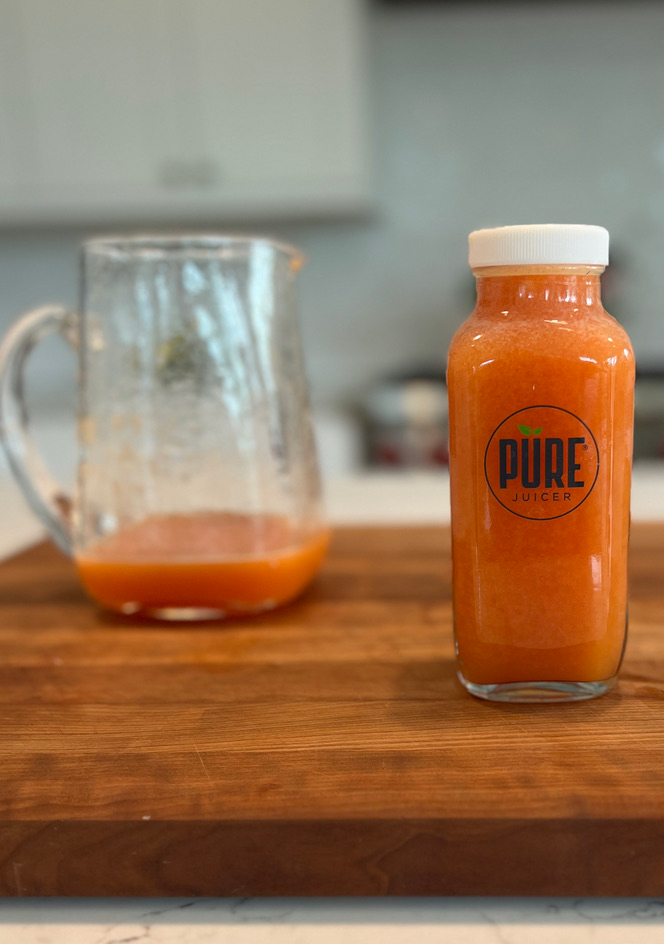
Recipe 2: Mango-Pineapple Juice
Ingredients
- 1 pineapple
- 2 mangoes
Directions
- Slice the pineapple into quarters (yes, leave the skin!)
- Slice around the mango stone
- Layer the mango on the pineapple (skin to skin)
- Repeat for each pineapple-mango combo.
- Press slowly.
Recipe 3: Pineapple-Passionfruit Juice
Ingredients
- ½ pineapple
- 2 passionfruit
Directions
- Slice the pineapple and then cut grooves in the top like a tic-tac-toe.
- Remove the fruit from the passionfruit shell and pour it on top of the pineapple slice.
- Wrap and press (slowly!)
Can I Juice Overripe Fruit?
Is it possible for a soft fruit to be too soft?
If you have a banana or an overripe mango, papaya, or other delicious soft fruit that is over the line for juicing, we strongly recommend that you cut it into small pieces, freeze it, and then turn it into “nice” cream using your PURE Juicer. Use a #4 grid, grind the frozen ingredients, and enjoy with your favorite toppings!

Are Tomatoes Considered a Soft Fruit?
Lastly, friends in our juicer community have asked us for the best way to juice tomatoes. Honestly, we juice tomatoes the same way we juice other soft fruit is done the same way as other soft fruit (tomatoes are fruit, after all!). Slice tomatoes in half. Place the tomatoes skin to skin. Wrap, and press SLOWLY.
Have we mentioned you should press soft fruit slowly?
Happy juicing!
Health Benefits
mangoes: high in immune-boosting Vitamin C and fiber, mangoes have been shown to reverse signs of aging and help protect the body from free radicals. Mangoes are also high in Vitamin B6, which aids in serotonin production to regulate our mood and better sleep.
papaya: a great source of fiber, calcium, magnesium, and potassium, papayas are also chock full of vitamins C, E, and K. The antioxidants found in papaya have been shown to protect against certain types of cancer and the onset of Alzheimer’s disease.
pineapple: delicious and packed with antioxidants, pineapples are known for their anti-inflammatory properties that can aid in a healthy immune system. Pineapples are a rich source of Vitamin C, manganese, and the compound bromelain, a group of digestive enzymes that may help break down protein and aid with digestion and could help fight against cancer.
lime: very high in vitamin C, limes also contain small amounts of iron, calcium, vitamin B6, thiamine, and potassium.
passion fruit: rich in antioxidants and low on calories, passion fruit is also a great source of fiber, vitamin C, vitamin A, iron, and beneficial plant compounds, including carotenoids and polyphenols.
Sources
Mangoes 101: Nutrition, Benefits, Types, and More
All About Papaya: Nutrition, Health Benefits, How to Use It
Pineapple: 8 Impressive Health Benefits
Limes: A Citrus Fruit with Powerful Benefits
Passion Fruit 101 – Everything You Need to Know
Medical Disclaimer
PURE Juicer is a juicing company. We are not doctors or medical experts. All content and information on this blog and website is for informational and educational purposes only, does not constitute medical advice, and does not establish any patient-client relationship by using this website.
Although we strive to provide accurate general information, the information presented here is not a substitute for professional advice. You should not rely solely on this information. Always consult a professional in your area for your health questions and concerns before making any professional, legal, medical, financial, or tax-related decisions.


